
Chapter 18: The Plants and Fungi
18.1 Overview of the Plants
Plants are multicellular, photosynthetic eukaryotes that evolved from freshwater green algae around 500 million years ago.
Green algae and plants share some characteristics, such as containing chlorophylls a and b, storing excess carbohydrates as starch, and having cellulose in their cell walls.
Land plants are most closely related to a group of freshwater green algae known as charophytes.
Charophytes protect the zygote, which is an important feature that separates land plants from green algae.
Plants have become well-adapted to a land existence but face challenges such as the constant threat of drying out.
To keep the internal environment of cells moist, a land plant must acquire water and transport it to all parts of the body while keeping the body in an erect position.
Plants have adapted to these problems by evolving an internal vascular system.
Figure 18.2 traces the evolutionary history of plants and associates each group with a major adaptation to existence on land.


An Overview of Plant Evolution
Mosses are low-lying plants that lack vascular tissue.
Mosses protect the embryo within a special structure and prevent the plant body from drying out.
Lycophytes were among the first plants to have a vascular system that transports water and solutes from the roots to the leaves of the plant body.
Plants with vascular tissue have true roots, stems, and leaves.
The leaves of lycophytes are called microphylls.
Ferns have large leaves called megaphylls.
The evolution of branching and leaves allowed a plant to increase the amount of exposure to sunlight, thus increasing photosynthesis and the production of sugars.
The evolution of seeds allowed a plant to protect the embryo and store organic nutrients within a protective coat.
Seeds are highly resistant structures well suited to protecting the plant embryos from drying out until conditions are favorable for germination.
Gymnosperms were the first seed plants to appear, about 360 MYA.
The final evolutionary event of interest is the evolution of the flower, a reproductive structure found in angiosperms.
Flowers attract pollinators, such as insects.
Flowers give rise to fruits that cover seeds.
Plants with flowers evolved between 120 and 140 MYA.
Alternation of Generations
Different from animals, which have a diploid life cycle.
Plants have an alternation of generations.
Two multicellular individuals alternate: sporophyte (2n) and gametophyte (n).
Sporophyte produces spores by meiosis.
The spore undergoes mitosis and becomes a gametophyte.
Gametophyte produces gametes through mitotic cell division.
Sperm and egg fuse to form a diploid zygote that becomes the sporophyte.
Meiosis produces haploid spores.
Mitosis is involved in the production of gametes during the gametophyte generation.

The Dominant Generation
In the plant life cycle, one of the two alternating generations is dominant.
The dominant generation carries out the majority of photosynthesis.
The major groups of plants differ as to which generation is dominant.
In mosses, the gametophyte is dominant.
In the other three groups of plants, the sporophyte is dominant.
The shift to sporophyte dominance is an adaptation to life on land.
As the sporophyte becomes dominant, the gametophyte becomes smaller and dependent upon the sporophyte.
In mosses, the gametophyte is much larger than the sporophyte.
In lycophytes and ferns, the gametophyte is a small, independent structure.
In cone-bearing and flowering plants, the female gametophyte is microscopic and retained within the body of the sporophyte plant.
The male gametophyte of seed plants lies within a pollen grain.
Pollen grains have strong, protective walls and are transported by wind, insects, and birds to reach the egg.
In the life cycle of seed plants, the spores, gametes, and zygotes are protected from drying out in the land environment.
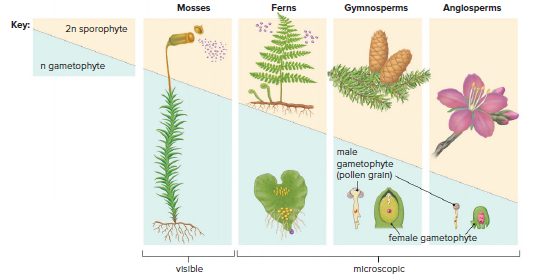
18.2 Diversity of Plants
Plants can be categorized into two groups: nonvascular and vascular.
Nonvascular plants receive water and nutrients through diffusion and osmosis directly into the plant body.
Nonvascular plants need to stay wet and remain very short.
Vascular plants have an internal transport system that facilitates the movement of water and nutrients throughout the body.
Vascular plants can live in drier conditions and increase in height to maximize photosynthesis.
Nonvascular Plants
Nonvascular plants include liverworts, hornworts, and mosses, collectively known as bryophytes.
Bryophytes lack true roots, stems, and leaves with well-developed vascular tissue.
In bryophytes, the gametophyte is the dominant generation, and the green, "leafy" part that produces gametes.
The Bryophyte gametophyte stage is completely dependent on water for reproduction.
After fertilization, the zygote becomes an embryo that develops into a sporophyte attached to and nourished by the photosynthetic gametophyte.
The sporophyte produces spores in a sporangium, which are dispersed by the wind and germinate in moist surroundings.
Irish moss is an edible red alga, reindeer moss is a lichen, club mosses are vascular plants, and Spanish moss is a flowering plant of the pineapple family.
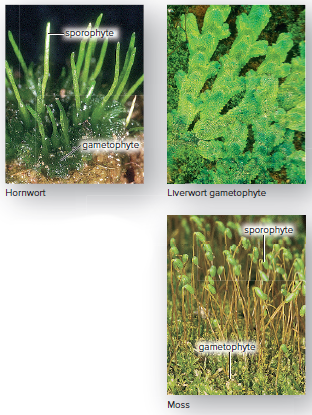
Adaptations and Uses of Bryophytes
Bryophytes, such as mosses, are short due to the lack of well-developed vascular tissue and the presence of swimming sperm.
Mosses can be found in various regions, from the Antarctic through the tropics to parts of the Arctic.
Most mosses prefer damp, shaded locations in the temperate zone, but some can survive in deserts and inhabit bogs and streams.
Mosses can form a mat that covers the ground and rotting logs in forests.
In dry environments, mosses may become shriveled and turn brown, but they can become green and resume metabolic activity as soon as it rains.
Mosses are better than flowering plants at living on stone walls, on fences, and in shady cracks of hot, exposed rocks.
Bryophytes can colonize bare rock and degrade it to soil that they can use for their own growth and that other organisms can also use.
Dead mosses, especially those of the genus Sphagnum, do not decay in wet and acidic areas like bogs, and the accumulated moss, called peat or bog moss, can be used as fuel.
Peat moss is commercially important because it has special, nonliving cells that can absorb moisture and is often used in gardens to improve the water-holding capacity of the soil.
Sphagnum moss has antiseptic qualities and was used as bandages in World War I when medics ran out of traditional bandages.
Vascular Plants
Vascular tissue is composed of xylem and phloem.
Xylem conducts water and minerals from the roots to other parts of the plant.
Phloem conducts organic solutes, such as sucrose, from one part of the plant to another.
Conducting cells in xylem have strengthened walls due to lignin, making them stronger, waterproof, and resistant to parasites and predators.
Vascular tissue and strong cell walls allow plants to grow tall.
Vascular plants have true roots, stems, and leaves.
Roots absorb water from the soil and stems conduct water to the leaves.
Leaves are covered by a waxy cuticle, except for stomata, which are little pores for gas exchange.
Stomata can be regulated to control water loss.
Seedless Vascular Plants
Certain vascular plants are seedless, such as lycophytes and ferns.
The other two groups of vascular plants are seed plants, namely gymnosperms and angiosperms.
Seedless vascular plants have a dominant sporophyte that produces windblown spores.
The independent gametophyte of seedless vascular plants produces flagellated sperm.
The flagellated sperm of seedless vascular plants require outside moisture to swim to an egg.
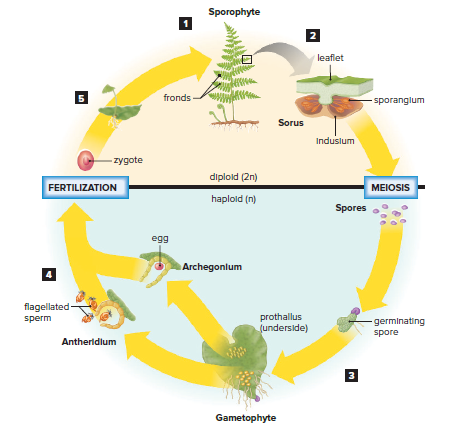
Lycophytes
Lycophytes, or club mosses, were one of the first land plants to have vascular tissue.
Lycophytes have well-developed vascular tissue in roots, stems, and leaves.
Lycophytes have a fleshy underground and horizontal stem called a rhizome.
Lycophytes have upright aerial stems with tightly packed, scale-like leaves.
Lycophytes have small leaves called microphylls, each with a single vein composed of xylem and phloem.
Lycophytes have sporangia borne on terminal clusters of leaves called strobilus, which are club-shaped.
Lycophytes' spores are sometimes harvested and sold as lycopodium powder or vegetable sulfur.
Lycopodium is common in moist woodlands in temperate climates, where they are called ground pines.
Lycopodium is abundant in the tropics and subtropics.
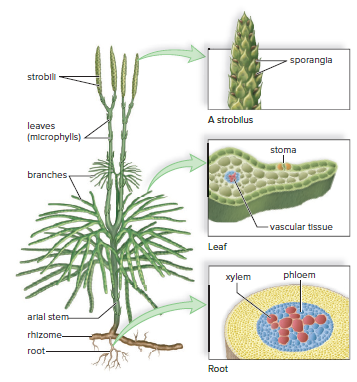
Ferns
Ferns are a widespread group of plants known for their attractiveness.
Ferns have megaphylls, which are large leaves with branched veins.
Megaphylls provide a large surface area for capturing sunlight and conduct water and minerals throughout the leaf tissue.
Ferns and other plants with megaphylls can produce food more efficiently than plants with microphylls.
Fern megaphylls are called fronds.
Sporangia are often located in clusters called sori on the undersides of the fronds.
The life cycle of a typical temperate fern involves a dominant sporophyte that produces windblown spores.
When the spores germinate, a tiny green gametophyte develops, separate from the sporophyte.
The gametophyte is water-dependent and lacks vascular tissue.
Flagellated sperm produced within antheridia require an outside source of moisture to swim to the eggs in the archegonia.
Upon fertilization, the zygote develops into a sporophyte.
In nearly all ferns, the leaves of the sporophyte first appear in a curled-up form called a fiddlehead, which unrolls as it grows.
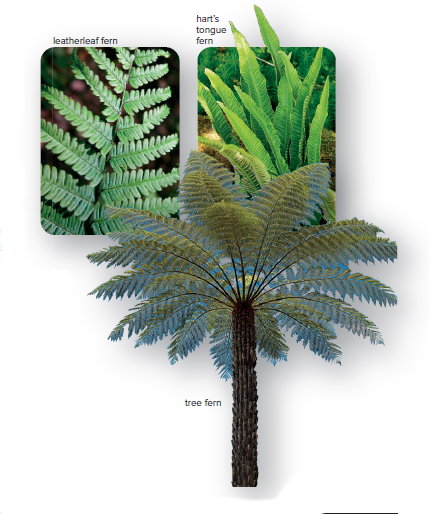
Ferns are commonly found in moist environments due to their small, water-dependent gametophyte that lacks vascular tissue.
Flagellated sperm require an outside source of moisture to swim to the eggs.
Some ferns, like the bracken fern, can spread into drier areas because their rhizomes produce new plants.
Ferns are used by florists in decorative bouquets and as ornamental plants in homes and gardens.
Wood from tropical tree ferns is used as a building material because it resists decay, particularly by termites.
Ferns, especially the ostrich fern, are used as food, and fiddleheads are considered a special treat in many northeastern US restaurants.
Ferns have medicinal value, and many Native Americans use ferns as an astringent during childbirth to stop bleeding. The maidenhair fern is the source of cold medicine.
Plants and Coal
Ferns and other seedless vascular plants were abundant during the Carboniferous period.
They were as large as trees.
A great swamp forest covered northern Europe, the Ukraine, and the Appalachian Mountains.
Many of these plants died and were compressed to form coal.
Seedless vascular plants are sometimes called the Coal Age plants.
Oil also had a similar origin, but it most likely formed in marine sedimentary rocks and includes animal remains.
Seed Plants
Seed plants are the most abundant land plants in the biosphere.
Trees, bushes, and garden plants are examples of seed plants.
The major parts of a seed are the seed coat, stored food, and sporophyte embryo.
The seed coat and stored food protect the embryo during dormancy until favorable conditions for growth.
Seeds can remain dormant for hundreds of years.
Germinating seeds use stored food as a source of nutrients for the growing seedling.
Seed plants have two types of spores that produce male and female gametophytes.
The male gametophyte is the pollen grain and produces sperm.
The female gametophyte is the ovule, which contains the egg.
Pollination occurs when pollen lands on the female reproductive structure.
Fertilization occurs when the sperm reaches the egg to form a diploid zygote.
In gymnosperms, seeds are "naked" and found in cones' grooves.
In angiosperms, seeds are "covered" and found inside a fruit.
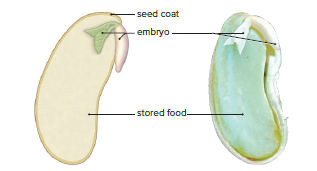
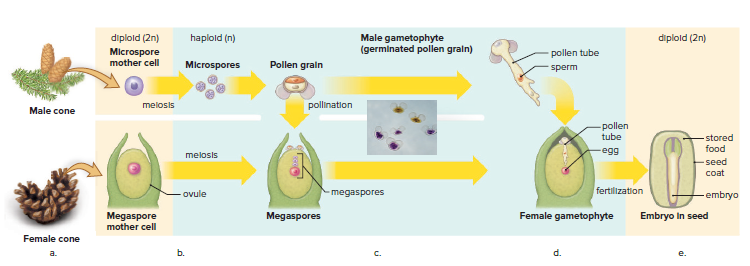
Gymnosperms
Gymnosperm means "naked seed."
Ovules and seeds are exposed on the surface of a cone scale in gymnosperms.
Ancient gymnosperms, such as cycads, were present in Carboniferous period swamp forests.
Conifers are a dominant plant group that are also gymnosperms.
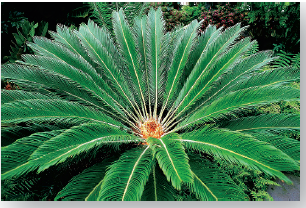
Conifers
Pines, spruces, firs, cedars, hemlocks, redwoods, and cypresses are all conifers.
Conifers are plants that bear cones containing the reproductive structures of the plant.
Other types of gymnosperms are also cone-bearing.
The coastal redwood is a conifer native to northwestern California and southwestern Oregon.
The coastal redwood is the tallest living vascular plant, reaching heights of nearly 100 m.
The bristlecone pine of the White Mountains of California is the oldest living tree.
One living specimen of the bristlecone pine is over 4,500 years old.
Some bristlecone pines have lived as long as 4,900 years.
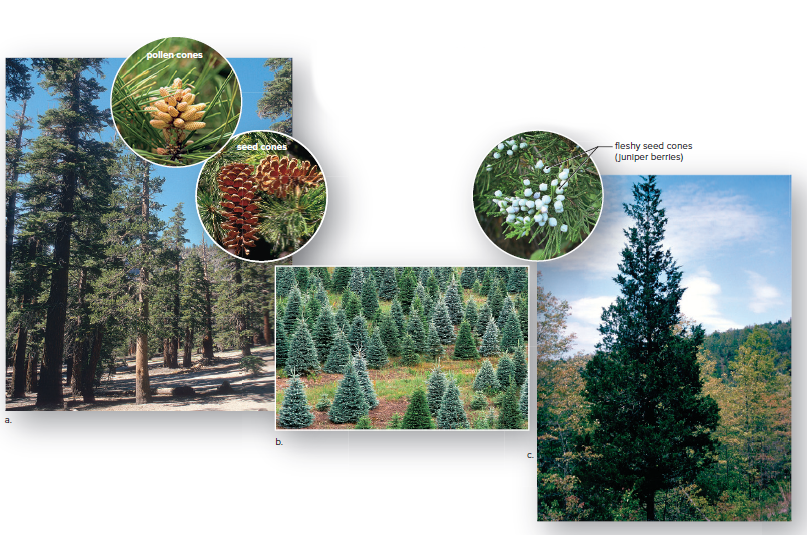
Pine trees are well adapted to dry conditions.
Pine trees have tough, needlelike leaves that conserve water.
Pine trees can live in areas where frozen topsoil makes it difficult for the roots to obtain plentiful water.
Resin protects leaves and other parts of pine trees from insect and fungal attacks.
The resin of certain pines is harvested; the liquid portion, called turpentine, is a paint thinner, while the solid portion is used on stringed instruments.
The wood of pines is used extensively in construction.
Vast forests of pines are planted for construction purposes.
The wood of pines is considered a "soft" rather than a "hard" wood.
The wood of pines consists primarily of xylem tissue that lacks some of the more rigid cell types found in flowering trees.
Angiosperms
Conifers are plants that bear cones containing the reproductive structures of the plant.
Pines, spruces, firs, cedars, hemlocks, redwoods, and cypresses are all conifers.
The coastal redwood is the tallest living vascular plant and can attain heights of nearly 100 m.
The bristlecone pine of the White Mountains of California is the oldest living tree, with some specimens living as long as 4,900 years.
Angiosperms are an exceptionally large and successful group of land plants, with over 270,000 known species.
They are also called flowering plants and live in all sorts of habitats.
Most garden plants produce flowers and therefore are angiosperms.
In northern climates, the trees that lose their leaves are flowering plants.
In subtropical and tropical climates, flowering trees, as well as gymnosperms, tend to keep their leaves all year.
The first fossils of angiosperms are no older than about 135 million years, but they probably arose much earlier.
Amborella trichopoda is the living plant that is most closely related to the first angiosperms.
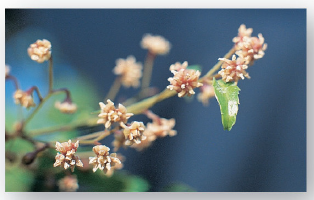
The Flower
Most flowers have common parts despite their different appearances.
The flower parts occur in whorls (circles) and include sepals, petals, stamens, and carpels.
Sepals, collectively called the calyx, protect the flower bud before it opens and may drop off or be colored like petals.
Petals, collectively called corolla, are diverse in size, shape, and color and often attract a particular pollinator.
Each stamen consists of a filament and an anther, where pollen is produced in pollen sacs.
Anther is positioned where pollen can be carried away by wind or a pollinator.
One or more carpels are at the center of a flower and have three major regions: ovary, style, and stigma.
The ovary is the swollen base containing from one to hundreds of ovules.
Style elevates the stigma, which is sticky or adapted for the reception of pollen grains.
Glands located in the region of the ovary produce nectar, a nutrient gathered by pollinators as they go from flower to flower.
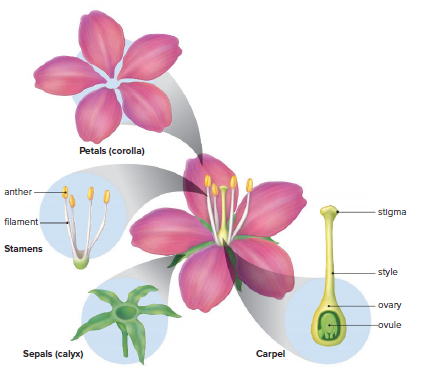
Flowering Plant Life Cycle
Angiosperms are flowering plants that produce seeds enclosed by fruit.
The ovary of a carpel contains several ovules, each of which holds an egg-bearing female gametophyte called an embryo sac.
During pollination, a pollen grain is transported from the anther of a stamen to the stigma of a carpel, where it germinates.
The pollen tube carries two sperm into an ovule, where double fertilization occurs.
One sperm unites with an egg nucleus, forming a diploid zygote, and the other sperm unites with two other nuclei, forming a triploid (3n) endosperm.
In angiosperms, the endosperm is the stored food.
The ovule ultimately becomes a seed that contains a sporophyte embryo.
Some seeds absorb the endosperm, while others digest it as the seed germinates.
Fruits are derived from an ovary and possibly accessory parts of the flower.
Some fruits provide a fleshy covering for their seeds, while others provide a dry covering.
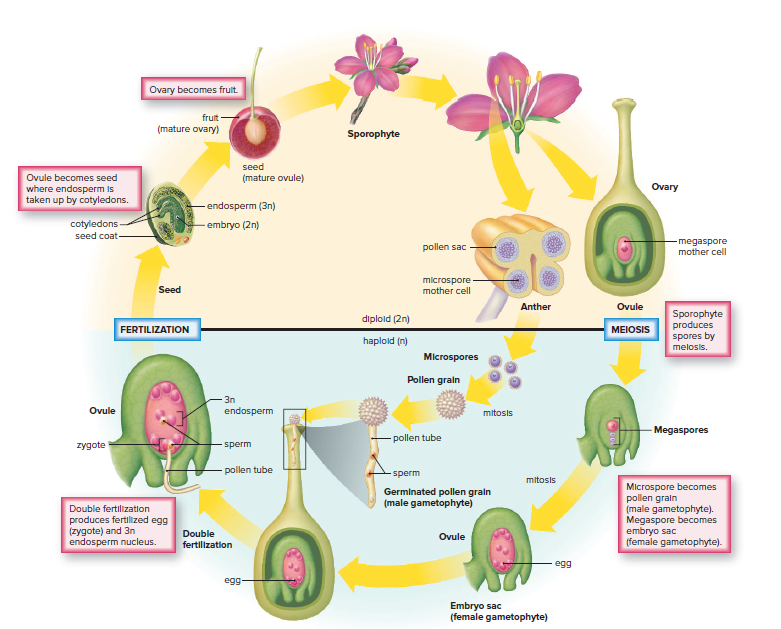
Adaptations and Uses of Angiosperms
Angiosperms need to disperse pollen and seeds to reproduce successfully.
Pollen can be dispersed by wind, insects, or animals.
Wind-pollinated flowers are usually inconspicuous, while insect- and animal-pollinated flowers are often brightly colored and fragrant.
Insects are attracted to flowers by their color, scent, and nectar.
Animals are attracted to fruits by their color, scent, and taste.
Fruits protect seeds and help them to disperse.
Seeds can be dispersed by wind, water, gravity, or animals.
Animals often disperse seeds to new locations when they eat fruits and then defecate the seeds.
This helps to ensure that the seeds germinate in a suitable environment.
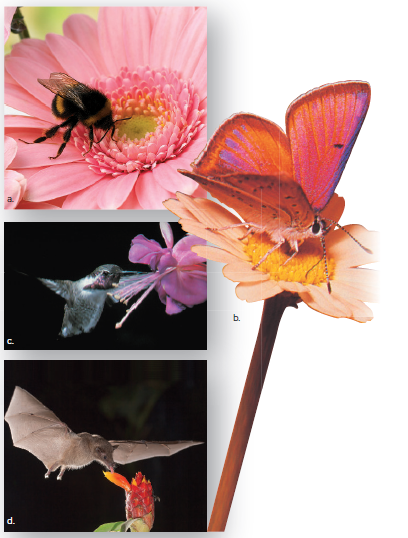
Economic Benefits of Plants
Plants have economic benefits, including the use of their fruits as food.
Botanists use the term fruit in a broader sense than laypeople.
Examples of fruits include apples, coconuts, grains, and pods containing beans or peas.
Cotton is derived from the cotton boll, which is a fruit containing seeds with seed hairs that become textile fibers.
Roots stems, and leaves of plants are used to make foods and commercial products.
Furniture, paper, and rope are made from the wood of a tree trunk or fibers from woody stems.
Plants produce many chemicals that makeup 50% of all pharmaceuticals and various other types of products.
The economic benefits of land plants are often dependent on pollinators.
The populations of honeybees and other pollinators have been declining worldwide, which endangers some plants.
We should protect pollinators because of our dependence on flowering plants.
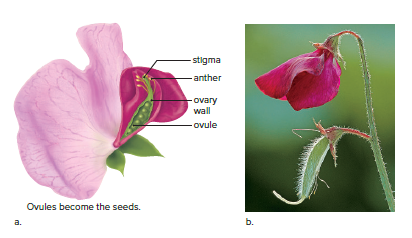
Ecological Benefits of Plants
Flowering plants are crucial for our existence due to their ecological benefits.
Plants produce food for themselves and other organisms in the biosphere.
Oxygen produced by plants through photosynthesis is used by all organisms that carry out cellular respiration.
Forests play an important role in the water and carbon cycle.
Tree roots hold soil in place and absorb water, which returns to the atmosphere.
Without trees and plants, rainwater runs off and contributes to flooding.
Plants absorb carbon dioxide, which lessens the amount in the atmosphere.
CO2 in the atmosphere contributes to global warming.
Burning tropical rainforests adds CO2 to the atmosphere and removes trees that absorb CO2.
Some plants, such as poplar, mustard, and mulberry species, can be used to clean up toxic messes by taking up pollutants from the soil.
18.3 The Fungi
Fungi are not closely related to plants or animals.
Fungi cannot photosynthesize because they lack chloroplasts.
Fungi are chemoheterotrophs, like animals, but they do not ingest their food.
Fungi release digestive enzymes into their environment and absorb the products of digestion.
Most fungi are nonmotile and do not have flagella.
Fungi produce windblown spores during both asexual and sexual life cycles.
The fungal life cycle differs from that of both animals and plants.
Fungi, plants, and animals are contrasted in Table 18.1.
Fungi are multicellular eukaryotes, except for yeasts and chytrids.
Fungi are not closely related to any other group of organisms.
DNA sequencing data suggest that fungi belong to the same eukaryotic supergroup as animals.
Fungi are more closely related to animals than to plants.
Fungi are believed to be the descendants of a flagellated protest.

General Biology of a Fungus
The evolutionary relationships of major groups of fungi are shown in Figure 18.19.
The general fungal structure is composed of hyphae, which are thin filaments of cells.
The main body of a fungus is the mycelium, which is a mass of hyphae.
The temporary reproductive structures of a fungus are the mushroom, puffball, or morel.
Fungal cells have cell walls made of chitin, a polysaccharide with amino sugars.
Walls or septa divide the cells of a hypha in many types of fungi.
The hyphae give the mycelium a large surface area, which facilitates nutrient absorption.
Hyphae extend towards a food source by growing at their tips, and the mycelium absorbs and passes nutrients to the growing tips.

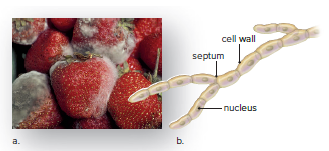
Fungai Diversity
Fungi are classified based on their mode of sexual reproduction.
Major fungal groups include:
Microsporidians
Chytrids
Zygospore fungi
Sac fungi
Club fungi
AM fungi.
Microsporidians
Single-celled microsporidians are parasites of animal cells.
They are commonly found in insects but can also be found in vertebrates such as fish, rabbits, and humans.
Biologists previously believed that these fungi were an ancient line of protists.
Genome sequencing of these organisms shows that they are more closely related to other fungi than to protists.
Chytrids
Chytrids are the most primitive of the fungi.
They are characterized by their motility.
Both spores and gametes of chytrids have flagella.
Chytrids are the only fungi that have flagella.
Some chytrids are single-celled, while others form hyphae without septa.
Some chytrids have an alternation-of-generations life cycle, which is uncommon among fungi.
Most chytrids inhabit water or soil.
Some chytrids live as parasites of plants and animals.
Zygospore Fungi--Black Bread Mold
Multicellular organisms have specialized cells.
Black bread mold is a type of zygospore fungi that has specialized hyphae.
Horizontal hyphae exist on the surface of the bread, while other hyphae grow into the bread and form stalks that bear sporangia.
The mycelia of two different mating types are featured in the center and bottom of Figure 18.22.
During asexual reproduction, each mycelium produces sporangia, where spore formation occurs.
Fungal spores are windblown, which is an advantage for a nonmotile organism living on land.
Sexual reproduction in fungi involves the conjugation of hyphae from different mating types.
In black bread mold, the tips of + and – hyphae join, the nuclei fuse, and a thick-walled zygospore results.
The zygospore undergoes a period of dormancy before it germinates, producing sporangia.
Meiosis occurs within the sporangia, producing spores of both mating types.
The spores, which are dispersed by air currents, give rise to new mycelia.
In fungi, only the zygote is diploid, and all other stages of the life cycle are haploid, which is a distinct difference from animals.
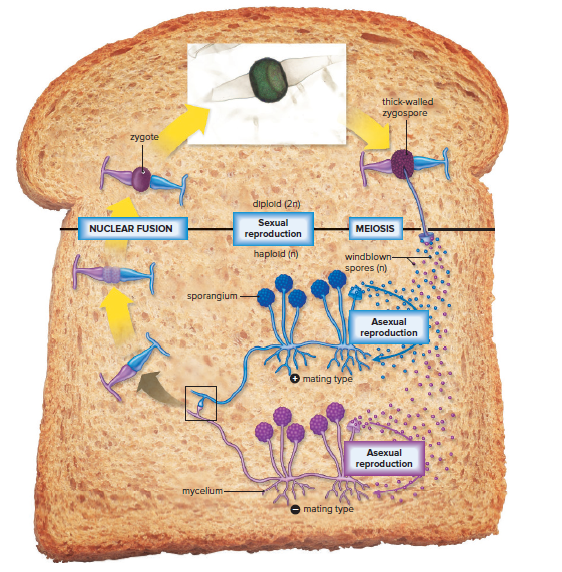
Club Fungi--the “Mushrooms”
The term mushroom refers to the fruiting body of fungi.
Most mushrooms belong to the club fungi, but some are sac fungi.
The fruiting body produces spores.
In mushrooms, the fusion of hyphae results in dikaryotic hyphae.
The mushroom consists of a stalk and a cap.
Basidia are club-shaped structures that project from the gills on the cap.
Nuclei fusion inside basidia is followed by meiosis and spore production.
Each mushroom cap produces tens of thousands of spores.
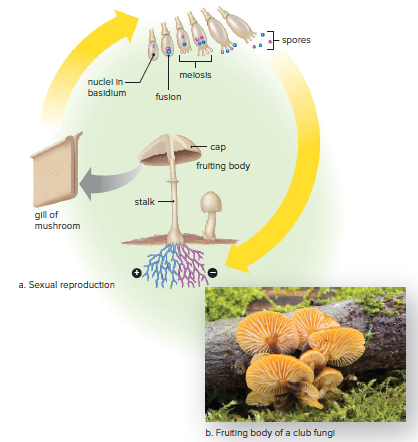
Sac Fungi
Approximately 75% of all known fungi are sac fungi, named for their ascocarp.
Sac fungi reproduce by producing chains of asexual spores called conidia.
Cup fungi, morels, and truffles have conspicuous ascocarps.
Truffles are underground symbionts of hazelnut and oak trees, highly prized as gourmet delights.
Pigs and dogs are trained to sniff out truffles in the woods, but truffles are also cultivated on the roots of seedlings.
Morels are often collected by chefs and other devotees because of their unique and delicate flavor.
False morels can be poisonous, and even true morels should not be eaten raw.
Yeasts are single-celled fungi, and many of these organisms are sac fungi.
Saccharomyces cerevisiae, brewer’s yeast, is representative of budding yeasts.
When some yeasts ferment, they produce ethanol and carbon dioxide.
Yeasts are added to grapes to produce wine, grains to make beer and liquor, and bread dough to make it rise.
The gas pockets in bread are preserved as the bread bakes.
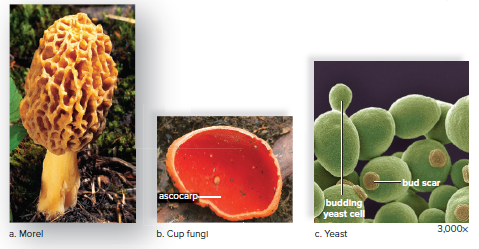
Ecological Benefits of Fungi
Most fungi are saprotrophs that decompose remains of plants, animals, and microbes in the soil.
Fungal enzymes can degrade cellulose and lignin in woody parts of plants, making them grow on dead trees.
Fungi can remove excess lignin from paper pulp, which is difficult to extract and ends up being a pollutant.
Fungi and bacteria play an indispensable role in returning inorganic nutrients to the soil.
Composting food scraps or yard waste provides excellent fertilizer.
Some fungi eat animals that they encounter while feeding on dead organic remains.
The oyster fungus secretes a substance that anesthetizes nematodes feeding on it, and other fungi snare, trap, or fire projectiles into nematodes and other small animals before digesting them.
Mutualistic Relationships
Mutualistic relationship: two different species live together and help each other.
Lichens: mutualistic associations between fungi and cyanobacteria or green algae.
The fungal partner provides water and minerals for the photosynthetic partner.
Photosynthetic partner provides organic molecules to the fungus.
Lichens produce organic matter and create new soil, allowing plants to invade the area.
Lichens occur in three varieties: compact crustose, shrublike fruticose, and leaflike foliose.
The body of a lichen has three layers: an upper layer, a lower layer, and a middle layer with photosynthetic cells.
Mycorrhizal fungi form mutualistic relationships with the roots of most plants.
Fungal hyphae greatly increase the surface area from which plant can absorb water and nutrients.
Mycorrhizal fungi may live on the outside of roots, enter between root cells, or penetrate root cells.
Arbuscular mycorrhizal (AM) fungi penetrate root cells with clumps of bushy hyphae and are associated with 80% of all vascular plants.
Fungus and plant cells exchange nutrients, with the fungus bringing water and minerals to the plant and the plant providing organic carbon to the fungus.
Mycorrhizal fungi may help plants adapt to life on dry land.
Truffles are the fruiting bodies of a mycorrhizal fungus that grows in oak and beech forests.
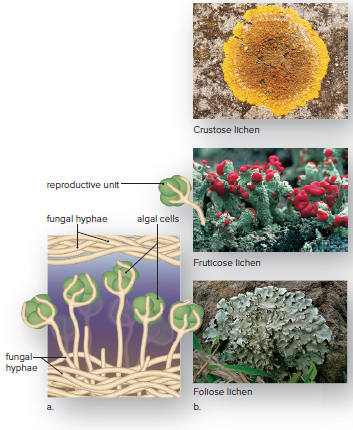
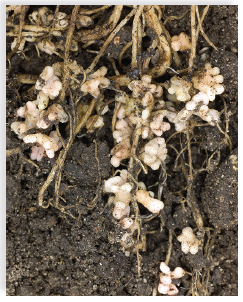
Economic Benefits of Fungi
Fungi are useful in producing medicines and various types of food.
Penicillium mold is the original source of penicillin, a breakthrough antibiotic that led to the important class of cillin antibiotics.
Cillin antibiotics have saved millions of lives.
The average person in the United States consumes over 2.6 pounds of mushrooms annually.
Mushrooms are used in soups, salads, omelets, and stir-fries and are an excellent low-calorie meat substitute with great nutritional value and lots of vitamins.
The white button mushroom, Agaricus bisporus, dominates the U.S. market, but brown-colored variants have surged in popularity in recent years.
Portabella is a marketing name used by the mushroom industry for the more flavorful brown strains of A. bisporus.
The crimini mushroom is the same brown strain as Portabella, but it is not allowed to open before it is harvested.
Shiitake and oyster mushrooms have slowly gained popularity over the past decade.
Shiitake is known for lowering cholesterol levels and having antitumor and antiviral properties.
Fungi as Disease-Causing Organisms
Fungi cause diseases in both plants and animals, including humans.
Fungi and Plant Diseases
Fungal pathogens are a major concern for farmers.
They usually enter plants through stomata or wounds.
Fungal diseases cause serious crop losses every year.
Panama disease threatens the typical banana found in grocery stores.
Rice blast disease destroys up to a third of the world's rice crop annually.
Corn smut is a major problem in the midwestern United States.
Rusts, a type of fungi, infect various plants, including fruit trees and grains.
Rusts have a complex life cycle that requires two different host species to complete.
Black stem rust of wheat uses barberry bushes as an alternate host.
Eradication of barberry bushes in areas where wheat is grown helps control this rust.
Fungicides are regularly applied to crops to limit the negative effects of fungal pathogens.
Wheat rust can also be controlled by producing new resistant strains of wheat.
Fungi and Animal Diseases
Certain mushrooms are poisonous.
Ergot fungus on grain can cause ergotism.
Mycoses are diseases caused by fungi.
Cutaneous mycoses affect only the epidermis.
Subcutaneous mycoses affect deeper skin layers.
Systemic mycoses spread their effects throughout the body by traveling in the bloodstream.
Fungal diseases contracted from the environment include ringworm, rose gardener’s disease, Chicago disease, and basketweaver’s disease.
Opportunistic fungal infections in AIDS patients stem from fungi that are always present in the body but take the opportunity to cause disease when the immune system becomes weakened.
Candida albicans causes the widest variety of fungal infections.
Vaginal Candida infections are commonly called “yeast infections” in women.
Oral thrush is a Candida infection of the mouth common in newborns and AIDS patients.
Candida can cause a systemic infection that can damage the heart, the brain, and other organs.
Ringworm is a cutaneous infection that does not penetrate the skin.
Athlete’s foot is a Tinea infection that affects the foot.
Batrachochytrium dendrobatidis causes chytridiomycosis in frogs.
Geomyces destructans causes white-nose syndrome in bats.
Researchers exploit biochemical differences between animals and fungi to design antibiotics.
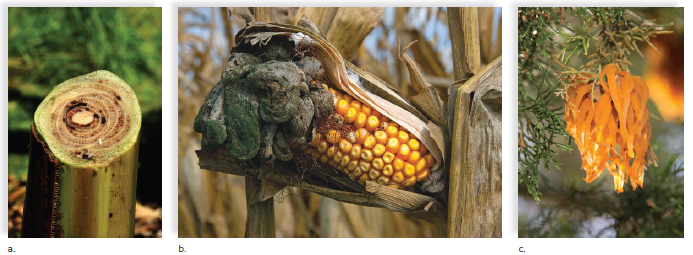
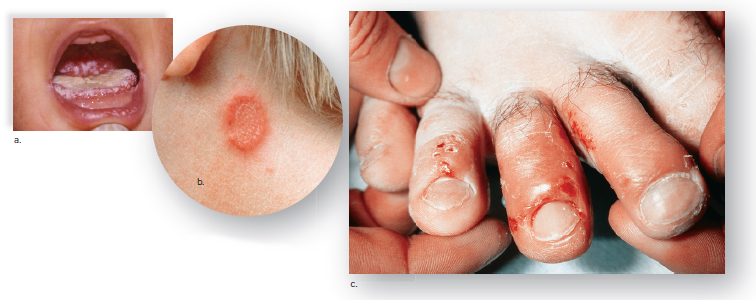
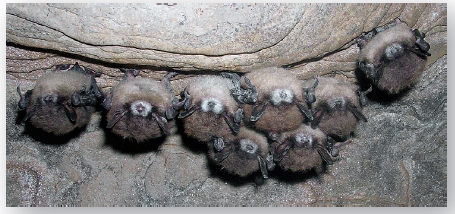
Chapter 18: The Plants and Fungi
18.1 Overview of the Plants
Plants are multicellular, photosynthetic eukaryotes that evolved from freshwater green algae around 500 million years ago.
Green algae and plants share some characteristics, such as containing chlorophylls a and b, storing excess carbohydrates as starch, and having cellulose in their cell walls.
Land plants are most closely related to a group of freshwater green algae known as charophytes.
Charophytes protect the zygote, which is an important feature that separates land plants from green algae.
Plants have become well-adapted to a land existence but face challenges such as the constant threat of drying out.
To keep the internal environment of cells moist, a land plant must acquire water and transport it to all parts of the body while keeping the body in an erect position.
Plants have adapted to these problems by evolving an internal vascular system.
Figure 18.2 traces the evolutionary history of plants and associates each group with a major adaptation to existence on land.


An Overview of Plant Evolution
Mosses are low-lying plants that lack vascular tissue.
Mosses protect the embryo within a special structure and prevent the plant body from drying out.
Lycophytes were among the first plants to have a vascular system that transports water and solutes from the roots to the leaves of the plant body.
Plants with vascular tissue have true roots, stems, and leaves.
The leaves of lycophytes are called microphylls.
Ferns have large leaves called megaphylls.
The evolution of branching and leaves allowed a plant to increase the amount of exposure to sunlight, thus increasing photosynthesis and the production of sugars.
The evolution of seeds allowed a plant to protect the embryo and store organic nutrients within a protective coat.
Seeds are highly resistant structures well suited to protecting the plant embryos from drying out until conditions are favorable for germination.
Gymnosperms were the first seed plants to appear, about 360 MYA.
The final evolutionary event of interest is the evolution of the flower, a reproductive structure found in angiosperms.
Flowers attract pollinators, such as insects.
Flowers give rise to fruits that cover seeds.
Plants with flowers evolved between 120 and 140 MYA.
Alternation of Generations
Different from animals, which have a diploid life cycle.
Plants have an alternation of generations.
Two multicellular individuals alternate: sporophyte (2n) and gametophyte (n).
Sporophyte produces spores by meiosis.
The spore undergoes mitosis and becomes a gametophyte.
Gametophyte produces gametes through mitotic cell division.
Sperm and egg fuse to form a diploid zygote that becomes the sporophyte.
Meiosis produces haploid spores.
Mitosis is involved in the production of gametes during the gametophyte generation.

The Dominant Generation
In the plant life cycle, one of the two alternating generations is dominant.
The dominant generation carries out the majority of photosynthesis.
The major groups of plants differ as to which generation is dominant.
In mosses, the gametophyte is dominant.
In the other three groups of plants, the sporophyte is dominant.
The shift to sporophyte dominance is an adaptation to life on land.
As the sporophyte becomes dominant, the gametophyte becomes smaller and dependent upon the sporophyte.
In mosses, the gametophyte is much larger than the sporophyte.
In lycophytes and ferns, the gametophyte is a small, independent structure.
In cone-bearing and flowering plants, the female gametophyte is microscopic and retained within the body of the sporophyte plant.
The male gametophyte of seed plants lies within a pollen grain.
Pollen grains have strong, protective walls and are transported by wind, insects, and birds to reach the egg.
In the life cycle of seed plants, the spores, gametes, and zygotes are protected from drying out in the land environment.

18.2 Diversity of Plants
Plants can be categorized into two groups: nonvascular and vascular.
Nonvascular plants receive water and nutrients through diffusion and osmosis directly into the plant body.
Nonvascular plants need to stay wet and remain very short.
Vascular plants have an internal transport system that facilitates the movement of water and nutrients throughout the body.
Vascular plants can live in drier conditions and increase in height to maximize photosynthesis.
Nonvascular Plants
Nonvascular plants include liverworts, hornworts, and mosses, collectively known as bryophytes.
Bryophytes lack true roots, stems, and leaves with well-developed vascular tissue.
In bryophytes, the gametophyte is the dominant generation, and the green, "leafy" part that produces gametes.
The Bryophyte gametophyte stage is completely dependent on water for reproduction.
After fertilization, the zygote becomes an embryo that develops into a sporophyte attached to and nourished by the photosynthetic gametophyte.
The sporophyte produces spores in a sporangium, which are dispersed by the wind and germinate in moist surroundings.
Irish moss is an edible red alga, reindeer moss is a lichen, club mosses are vascular plants, and Spanish moss is a flowering plant of the pineapple family.

Adaptations and Uses of Bryophytes
Bryophytes, such as mosses, are short due to the lack of well-developed vascular tissue and the presence of swimming sperm.
Mosses can be found in various regions, from the Antarctic through the tropics to parts of the Arctic.
Most mosses prefer damp, shaded locations in the temperate zone, but some can survive in deserts and inhabit bogs and streams.
Mosses can form a mat that covers the ground and rotting logs in forests.
In dry environments, mosses may become shriveled and turn brown, but they can become green and resume metabolic activity as soon as it rains.
Mosses are better than flowering plants at living on stone walls, on fences, and in shady cracks of hot, exposed rocks.
Bryophytes can colonize bare rock and degrade it to soil that they can use for their own growth and that other organisms can also use.
Dead mosses, especially those of the genus Sphagnum, do not decay in wet and acidic areas like bogs, and the accumulated moss, called peat or bog moss, can be used as fuel.
Peat moss is commercially important because it has special, nonliving cells that can absorb moisture and is often used in gardens to improve the water-holding capacity of the soil.
Sphagnum moss has antiseptic qualities and was used as bandages in World War I when medics ran out of traditional bandages.
Vascular Plants
Vascular tissue is composed of xylem and phloem.
Xylem conducts water and minerals from the roots to other parts of the plant.
Phloem conducts organic solutes, such as sucrose, from one part of the plant to another.
Conducting cells in xylem have strengthened walls due to lignin, making them stronger, waterproof, and resistant to parasites and predators.
Vascular tissue and strong cell walls allow plants to grow tall.
Vascular plants have true roots, stems, and leaves.
Roots absorb water from the soil and stems conduct water to the leaves.
Leaves are covered by a waxy cuticle, except for stomata, which are little pores for gas exchange.
Stomata can be regulated to control water loss.
Seedless Vascular Plants
Certain vascular plants are seedless, such as lycophytes and ferns.
The other two groups of vascular plants are seed plants, namely gymnosperms and angiosperms.
Seedless vascular plants have a dominant sporophyte that produces windblown spores.
The independent gametophyte of seedless vascular plants produces flagellated sperm.
The flagellated sperm of seedless vascular plants require outside moisture to swim to an egg.

Lycophytes
Lycophytes, or club mosses, were one of the first land plants to have vascular tissue.
Lycophytes have well-developed vascular tissue in roots, stems, and leaves.
Lycophytes have a fleshy underground and horizontal stem called a rhizome.
Lycophytes have upright aerial stems with tightly packed, scale-like leaves.
Lycophytes have small leaves called microphylls, each with a single vein composed of xylem and phloem.
Lycophytes have sporangia borne on terminal clusters of leaves called strobilus, which are club-shaped.
Lycophytes' spores are sometimes harvested and sold as lycopodium powder or vegetable sulfur.
Lycopodium is common in moist woodlands in temperate climates, where they are called ground pines.
Lycopodium is abundant in the tropics and subtropics.

Ferns
Ferns are a widespread group of plants known for their attractiveness.
Ferns have megaphylls, which are large leaves with branched veins.
Megaphylls provide a large surface area for capturing sunlight and conduct water and minerals throughout the leaf tissue.
Ferns and other plants with megaphylls can produce food more efficiently than plants with microphylls.
Fern megaphylls are called fronds.
Sporangia are often located in clusters called sori on the undersides of the fronds.
The life cycle of a typical temperate fern involves a dominant sporophyte that produces windblown spores.
When the spores germinate, a tiny green gametophyte develops, separate from the sporophyte.
The gametophyte is water-dependent and lacks vascular tissue.
Flagellated sperm produced within antheridia require an outside source of moisture to swim to the eggs in the archegonia.
Upon fertilization, the zygote develops into a sporophyte.
In nearly all ferns, the leaves of the sporophyte first appear in a curled-up form called a fiddlehead, which unrolls as it grows.

Ferns are commonly found in moist environments due to their small, water-dependent gametophyte that lacks vascular tissue.
Flagellated sperm require an outside source of moisture to swim to the eggs.
Some ferns, like the bracken fern, can spread into drier areas because their rhizomes produce new plants.
Ferns are used by florists in decorative bouquets and as ornamental plants in homes and gardens.
Wood from tropical tree ferns is used as a building material because it resists decay, particularly by termites.
Ferns, especially the ostrich fern, are used as food, and fiddleheads are considered a special treat in many northeastern US restaurants.
Ferns have medicinal value, and many Native Americans use ferns as an astringent during childbirth to stop bleeding. The maidenhair fern is the source of cold medicine.
Plants and Coal
Ferns and other seedless vascular plants were abundant during the Carboniferous period.
They were as large as trees.
A great swamp forest covered northern Europe, the Ukraine, and the Appalachian Mountains.
Many of these plants died and were compressed to form coal.
Seedless vascular plants are sometimes called the Coal Age plants.
Oil also had a similar origin, but it most likely formed in marine sedimentary rocks and includes animal remains.
Seed Plants
Seed plants are the most abundant land plants in the biosphere.
Trees, bushes, and garden plants are examples of seed plants.
The major parts of a seed are the seed coat, stored food, and sporophyte embryo.
The seed coat and stored food protect the embryo during dormancy until favorable conditions for growth.
Seeds can remain dormant for hundreds of years.
Germinating seeds use stored food as a source of nutrients for the growing seedling.
Seed plants have two types of spores that produce male and female gametophytes.
The male gametophyte is the pollen grain and produces sperm.
The female gametophyte is the ovule, which contains the egg.
Pollination occurs when pollen lands on the female reproductive structure.
Fertilization occurs when the sperm reaches the egg to form a diploid zygote.
In gymnosperms, seeds are "naked" and found in cones' grooves.
In angiosperms, seeds are "covered" and found inside a fruit.


Gymnosperms
Gymnosperm means "naked seed."
Ovules and seeds are exposed on the surface of a cone scale in gymnosperms.
Ancient gymnosperms, such as cycads, were present in Carboniferous period swamp forests.
Conifers are a dominant plant group that are also gymnosperms.

Conifers
Pines, spruces, firs, cedars, hemlocks, redwoods, and cypresses are all conifers.
Conifers are plants that bear cones containing the reproductive structures of the plant.
Other types of gymnosperms are also cone-bearing.
The coastal redwood is a conifer native to northwestern California and southwestern Oregon.
The coastal redwood is the tallest living vascular plant, reaching heights of nearly 100 m.
The bristlecone pine of the White Mountains of California is the oldest living tree.
One living specimen of the bristlecone pine is over 4,500 years old.
Some bristlecone pines have lived as long as 4,900 years.

Pine trees are well adapted to dry conditions.
Pine trees have tough, needlelike leaves that conserve water.
Pine trees can live in areas where frozen topsoil makes it difficult for the roots to obtain plentiful water.
Resin protects leaves and other parts of pine trees from insect and fungal attacks.
The resin of certain pines is harvested; the liquid portion, called turpentine, is a paint thinner, while the solid portion is used on stringed instruments.
The wood of pines is used extensively in construction.
Vast forests of pines are planted for construction purposes.
The wood of pines is considered a "soft" rather than a "hard" wood.
The wood of pines consists primarily of xylem tissue that lacks some of the more rigid cell types found in flowering trees.
Angiosperms
Conifers are plants that bear cones containing the reproductive structures of the plant.
Pines, spruces, firs, cedars, hemlocks, redwoods, and cypresses are all conifers.
The coastal redwood is the tallest living vascular plant and can attain heights of nearly 100 m.
The bristlecone pine of the White Mountains of California is the oldest living tree, with some specimens living as long as 4,900 years.
Angiosperms are an exceptionally large and successful group of land plants, with over 270,000 known species.
They are also called flowering plants and live in all sorts of habitats.
Most garden plants produce flowers and therefore are angiosperms.
In northern climates, the trees that lose their leaves are flowering plants.
In subtropical and tropical climates, flowering trees, as well as gymnosperms, tend to keep their leaves all year.
The first fossils of angiosperms are no older than about 135 million years, but they probably arose much earlier.
Amborella trichopoda is the living plant that is most closely related to the first angiosperms.

The Flower
Most flowers have common parts despite their different appearances.
The flower parts occur in whorls (circles) and include sepals, petals, stamens, and carpels.
Sepals, collectively called the calyx, protect the flower bud before it opens and may drop off or be colored like petals.
Petals, collectively called corolla, are diverse in size, shape, and color and often attract a particular pollinator.
Each stamen consists of a filament and an anther, where pollen is produced in pollen sacs.
Anther is positioned where pollen can be carried away by wind or a pollinator.
One or more carpels are at the center of a flower and have three major regions: ovary, style, and stigma.
The ovary is the swollen base containing from one to hundreds of ovules.
Style elevates the stigma, which is sticky or adapted for the reception of pollen grains.
Glands located in the region of the ovary produce nectar, a nutrient gathered by pollinators as they go from flower to flower.

Flowering Plant Life Cycle
Angiosperms are flowering plants that produce seeds enclosed by fruit.
The ovary of a carpel contains several ovules, each of which holds an egg-bearing female gametophyte called an embryo sac.
During pollination, a pollen grain is transported from the anther of a stamen to the stigma of a carpel, where it germinates.
The pollen tube carries two sperm into an ovule, where double fertilization occurs.
One sperm unites with an egg nucleus, forming a diploid zygote, and the other sperm unites with two other nuclei, forming a triploid (3n) endosperm.
In angiosperms, the endosperm is the stored food.
The ovule ultimately becomes a seed that contains a sporophyte embryo.
Some seeds absorb the endosperm, while others digest it as the seed germinates.
Fruits are derived from an ovary and possibly accessory parts of the flower.
Some fruits provide a fleshy covering for their seeds, while others provide a dry covering.

Adaptations and Uses of Angiosperms
Angiosperms need to disperse pollen and seeds to reproduce successfully.
Pollen can be dispersed by wind, insects, or animals.
Wind-pollinated flowers are usually inconspicuous, while insect- and animal-pollinated flowers are often brightly colored and fragrant.
Insects are attracted to flowers by their color, scent, and nectar.
Animals are attracted to fruits by their color, scent, and taste.
Fruits protect seeds and help them to disperse.
Seeds can be dispersed by wind, water, gravity, or animals.
Animals often disperse seeds to new locations when they eat fruits and then defecate the seeds.
This helps to ensure that the seeds germinate in a suitable environment.

Economic Benefits of Plants
Plants have economic benefits, including the use of their fruits as food.
Botanists use the term fruit in a broader sense than laypeople.
Examples of fruits include apples, coconuts, grains, and pods containing beans or peas.
Cotton is derived from the cotton boll, which is a fruit containing seeds with seed hairs that become textile fibers.
Roots stems, and leaves of plants are used to make foods and commercial products.
Furniture, paper, and rope are made from the wood of a tree trunk or fibers from woody stems.
Plants produce many chemicals that makeup 50% of all pharmaceuticals and various other types of products.
The economic benefits of land plants are often dependent on pollinators.
The populations of honeybees and other pollinators have been declining worldwide, which endangers some plants.
We should protect pollinators because of our dependence on flowering plants.

Ecological Benefits of Plants
Flowering plants are crucial for our existence due to their ecological benefits.
Plants produce food for themselves and other organisms in the biosphere.
Oxygen produced by plants through photosynthesis is used by all organisms that carry out cellular respiration.
Forests play an important role in the water and carbon cycle.
Tree roots hold soil in place and absorb water, which returns to the atmosphere.
Without trees and plants, rainwater runs off and contributes to flooding.
Plants absorb carbon dioxide, which lessens the amount in the atmosphere.
CO2 in the atmosphere contributes to global warming.
Burning tropical rainforests adds CO2 to the atmosphere and removes trees that absorb CO2.
Some plants, such as poplar, mustard, and mulberry species, can be used to clean up toxic messes by taking up pollutants from the soil.
18.3 The Fungi
Fungi are not closely related to plants or animals.
Fungi cannot photosynthesize because they lack chloroplasts.
Fungi are chemoheterotrophs, like animals, but they do not ingest their food.
Fungi release digestive enzymes into their environment and absorb the products of digestion.
Most fungi are nonmotile and do not have flagella.
Fungi produce windblown spores during both asexual and sexual life cycles.
The fungal life cycle differs from that of both animals and plants.
Fungi, plants, and animals are contrasted in Table 18.1.
Fungi are multicellular eukaryotes, except for yeasts and chytrids.
Fungi are not closely related to any other group of organisms.
DNA sequencing data suggest that fungi belong to the same eukaryotic supergroup as animals.
Fungi are more closely related to animals than to plants.
Fungi are believed to be the descendants of a flagellated protest.

General Biology of a Fungus
The evolutionary relationships of major groups of fungi are shown in Figure 18.19.
The general fungal structure is composed of hyphae, which are thin filaments of cells.
The main body of a fungus is the mycelium, which is a mass of hyphae.
The temporary reproductive structures of a fungus are the mushroom, puffball, or morel.
Fungal cells have cell walls made of chitin, a polysaccharide with amino sugars.
Walls or septa divide the cells of a hypha in many types of fungi.
The hyphae give the mycelium a large surface area, which facilitates nutrient absorption.
Hyphae extend towards a food source by growing at their tips, and the mycelium absorbs and passes nutrients to the growing tips.


Fungai Diversity
Fungi are classified based on their mode of sexual reproduction.
Major fungal groups include:
Microsporidians
Chytrids
Zygospore fungi
Sac fungi
Club fungi
AM fungi.
Microsporidians
Single-celled microsporidians are parasites of animal cells.
They are commonly found in insects but can also be found in vertebrates such as fish, rabbits, and humans.
Biologists previously believed that these fungi were an ancient line of protists.
Genome sequencing of these organisms shows that they are more closely related to other fungi than to protists.
Chytrids
Chytrids are the most primitive of the fungi.
They are characterized by their motility.
Both spores and gametes of chytrids have flagella.
Chytrids are the only fungi that have flagella.
Some chytrids are single-celled, while others form hyphae without septa.
Some chytrids have an alternation-of-generations life cycle, which is uncommon among fungi.
Most chytrids inhabit water or soil.
Some chytrids live as parasites of plants and animals.
Zygospore Fungi--Black Bread Mold
Multicellular organisms have specialized cells.
Black bread mold is a type of zygospore fungi that has specialized hyphae.
Horizontal hyphae exist on the surface of the bread, while other hyphae grow into the bread and form stalks that bear sporangia.
The mycelia of two different mating types are featured in the center and bottom of Figure 18.22.
During asexual reproduction, each mycelium produces sporangia, where spore formation occurs.
Fungal spores are windblown, which is an advantage for a nonmotile organism living on land.
Sexual reproduction in fungi involves the conjugation of hyphae from different mating types.
In black bread mold, the tips of + and – hyphae join, the nuclei fuse, and a thick-walled zygospore results.
The zygospore undergoes a period of dormancy before it germinates, producing sporangia.
Meiosis occurs within the sporangia, producing spores of both mating types.
The spores, which are dispersed by air currents, give rise to new mycelia.
In fungi, only the zygote is diploid, and all other stages of the life cycle are haploid, which is a distinct difference from animals.

Club Fungi--the “Mushrooms”
The term mushroom refers to the fruiting body of fungi.
Most mushrooms belong to the club fungi, but some are sac fungi.
The fruiting body produces spores.
In mushrooms, the fusion of hyphae results in dikaryotic hyphae.
The mushroom consists of a stalk and a cap.
Basidia are club-shaped structures that project from the gills on the cap.
Nuclei fusion inside basidia is followed by meiosis and spore production.
Each mushroom cap produces tens of thousands of spores.

Sac Fungi
Approximately 75% of all known fungi are sac fungi, named for their ascocarp.
Sac fungi reproduce by producing chains of asexual spores called conidia.
Cup fungi, morels, and truffles have conspicuous ascocarps.
Truffles are underground symbionts of hazelnut and oak trees, highly prized as gourmet delights.
Pigs and dogs are trained to sniff out truffles in the woods, but truffles are also cultivated on the roots of seedlings.
Morels are often collected by chefs and other devotees because of their unique and delicate flavor.
False morels can be poisonous, and even true morels should not be eaten raw.
Yeasts are single-celled fungi, and many of these organisms are sac fungi.
Saccharomyces cerevisiae, brewer’s yeast, is representative of budding yeasts.
When some yeasts ferment, they produce ethanol and carbon dioxide.
Yeasts are added to grapes to produce wine, grains to make beer and liquor, and bread dough to make it rise.
The gas pockets in bread are preserved as the bread bakes.

Ecological Benefits of Fungi
Most fungi are saprotrophs that decompose remains of plants, animals, and microbes in the soil.
Fungal enzymes can degrade cellulose and lignin in woody parts of plants, making them grow on dead trees.
Fungi can remove excess lignin from paper pulp, which is difficult to extract and ends up being a pollutant.
Fungi and bacteria play an indispensable role in returning inorganic nutrients to the soil.
Composting food scraps or yard waste provides excellent fertilizer.
Some fungi eat animals that they encounter while feeding on dead organic remains.
The oyster fungus secretes a substance that anesthetizes nematodes feeding on it, and other fungi snare, trap, or fire projectiles into nematodes and other small animals before digesting them.
Mutualistic Relationships
Mutualistic relationship: two different species live together and help each other.
Lichens: mutualistic associations between fungi and cyanobacteria or green algae.
The fungal partner provides water and minerals for the photosynthetic partner.
Photosynthetic partner provides organic molecules to the fungus.
Lichens produce organic matter and create new soil, allowing plants to invade the area.
Lichens occur in three varieties: compact crustose, shrublike fruticose, and leaflike foliose.
The body of a lichen has three layers: an upper layer, a lower layer, and a middle layer with photosynthetic cells.
Mycorrhizal fungi form mutualistic relationships with the roots of most plants.
Fungal hyphae greatly increase the surface area from which plant can absorb water and nutrients.
Mycorrhizal fungi may live on the outside of roots, enter between root cells, or penetrate root cells.
Arbuscular mycorrhizal (AM) fungi penetrate root cells with clumps of bushy hyphae and are associated with 80% of all vascular plants.
Fungus and plant cells exchange nutrients, with the fungus bringing water and minerals to the plant and the plant providing organic carbon to the fungus.
Mycorrhizal fungi may help plants adapt to life on dry land.
Truffles are the fruiting bodies of a mycorrhizal fungus that grows in oak and beech forests.


Economic Benefits of Fungi
Fungi are useful in producing medicines and various types of food.
Penicillium mold is the original source of penicillin, a breakthrough antibiotic that led to the important class of cillin antibiotics.
Cillin antibiotics have saved millions of lives.
The average person in the United States consumes over 2.6 pounds of mushrooms annually.
Mushrooms are used in soups, salads, omelets, and stir-fries and are an excellent low-calorie meat substitute with great nutritional value and lots of vitamins.
The white button mushroom, Agaricus bisporus, dominates the U.S. market, but brown-colored variants have surged in popularity in recent years.
Portabella is a marketing name used by the mushroom industry for the more flavorful brown strains of A. bisporus.
The crimini mushroom is the same brown strain as Portabella, but it is not allowed to open before it is harvested.
Shiitake and oyster mushrooms have slowly gained popularity over the past decade.
Shiitake is known for lowering cholesterol levels and having antitumor and antiviral properties.
Fungi as Disease-Causing Organisms
Fungi cause diseases in both plants and animals, including humans.
Fungi and Plant Diseases
Fungal pathogens are a major concern for farmers.
They usually enter plants through stomata or wounds.
Fungal diseases cause serious crop losses every year.
Panama disease threatens the typical banana found in grocery stores.
Rice blast disease destroys up to a third of the world's rice crop annually.
Corn smut is a major problem in the midwestern United States.
Rusts, a type of fungi, infect various plants, including fruit trees and grains.
Rusts have a complex life cycle that requires two different host species to complete.
Black stem rust of wheat uses barberry bushes as an alternate host.
Eradication of barberry bushes in areas where wheat is grown helps control this rust.
Fungicides are regularly applied to crops to limit the negative effects of fungal pathogens.
Wheat rust can also be controlled by producing new resistant strains of wheat.
Fungi and Animal Diseases
Certain mushrooms are poisonous.
Ergot fungus on grain can cause ergotism.
Mycoses are diseases caused by fungi.
Cutaneous mycoses affect only the epidermis.
Subcutaneous mycoses affect deeper skin layers.
Systemic mycoses spread their effects throughout the body by traveling in the bloodstream.
Fungal diseases contracted from the environment include ringworm, rose gardener’s disease, Chicago disease, and basketweaver’s disease.
Opportunistic fungal infections in AIDS patients stem from fungi that are always present in the body but take the opportunity to cause disease when the immune system becomes weakened.
Candida albicans causes the widest variety of fungal infections.
Vaginal Candida infections are commonly called “yeast infections” in women.
Oral thrush is a Candida infection of the mouth common in newborns and AIDS patients.
Candida can cause a systemic infection that can damage the heart, the brain, and other organs.
Ringworm is a cutaneous infection that does not penetrate the skin.
Athlete’s foot is a Tinea infection that affects the foot.
Batrachochytrium dendrobatidis causes chytridiomycosis in frogs.
Geomyces destructans causes white-nose syndrome in bats.
Researchers exploit biochemical differences between animals and fungi to design antibiotics.



 Knowt
Knowt
